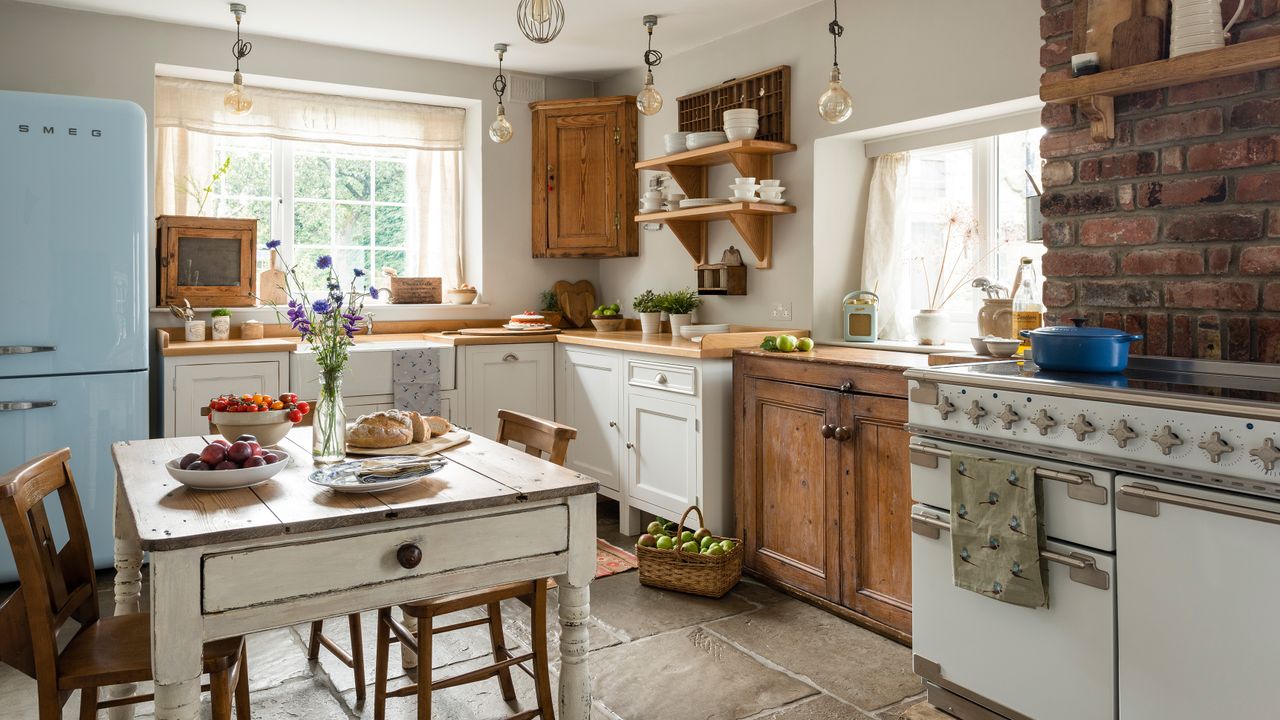
Looking for inspiration for renovating your period home? Amongst our home transformations is this beautiful listed stone cottage in North Yorkshire, which had water streaming down the gloss-painted walls and wringing wet carpets when Gemma and Doug first went to view it.
Project notes
Owners: Gemma Carsey and Doug Tomlinson, both solicitors, live here with their two Lhasa Apso dogs Muffin and Toastie
The property: A Grade II-listed three-bedroom cottage in a conservation village in the North York Moors. The original cottage dates back to the 1700s, but the kitchen and dining room were added in the 1800s. The garage arch is from the 19th century, with the top part being converted into a bedroom in the 20th century
What they did: They stripped the walls, exposed original floorboards, replaced kitchen and bathroom fittings, painted beams and laid new flooring
It would have put off most people, but the structure of the building was sound and the garden included stabling for horses – a huge bonus for Gemma, who is a keen rider – plus a barn that had been converted into accommodation.
‘We saw potential in the cottage and realised we could live in the barn while we did the renovation work,’ recalls Gemma. ‘We loved its location and character, so we bought it. It was a gamble – and it turned out to be quite a stressful project.’
The challenge began as soon as they moved into the barn and realised it was almost as damp as the cottage. But it only spurred them on to complete the work to the cottage before winter set in. ‘The damp was definitely the biggest issue,’ says Gemma. ‘We think the walls had been glossed to make them easier to clean, but it actually created more moisture as the thick walls couldn’t breathe, and old cottages like this need good airflow.’
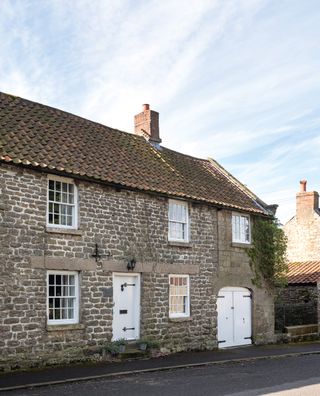
Set in a pretty village in the North York Moors, the cottage dates back to the 1700s and has been extended over the years
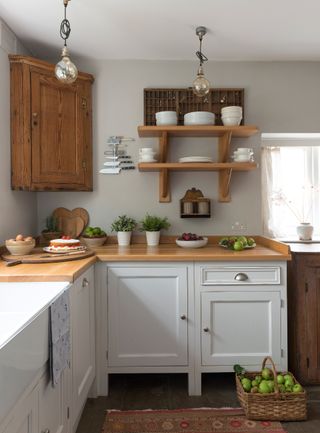
The couple like to mix old with new, and urban with country style, so couldn’t resist these industrial-style light fittings from Urban Cottage Industries
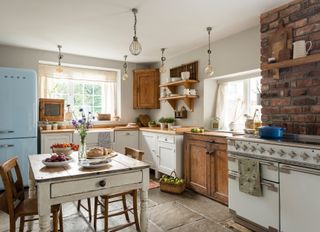
The kitchen units were made by a joiner to Gemma’s design, to fit round an old pine cupboard positioned next to the range cooker. He also made the oak worktops and a plate rack. Modern appliances from Rangemaster and Smeg look perfectly at home in the country setting, alongside vintage chairs sourced from a chapel in Devon. The dining table is a car boot sale find, and the curtains are made from old French sheets monogrammed with the couple’s initials, from Cloth House in London. The flooring is from Farmhouse Flagstones and the walls are painted in Cornforth White and the units in Wevet, both Farrow & Ball
Their first – and very laborious – task was to strip all the paint off the walls, which came away in sheets. They then opened the doors and windows and turned on the heating to allow the cottage to dry out over a period of six weeks.
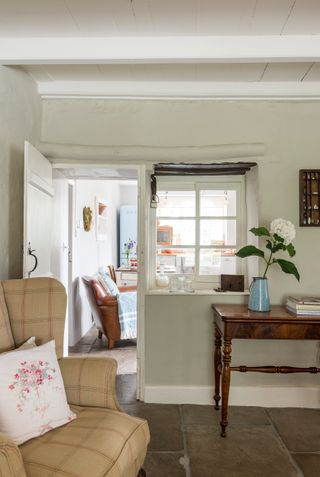
A glass partition, thought to have once been a window in an exterior wall, draws light between the kitchen and dining rooms
While the property started to breathe again, they took up three layers of soaking wet carpet in the kitchen and removed the living room carpet to reveal the original wide-plank floors, which Doug sanded by hand to maintain the character.
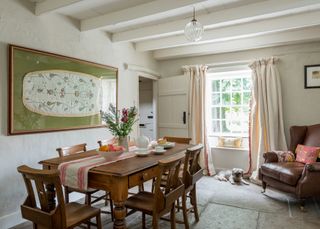
The table is an old desk, bought for £170 from nearby Ampleforth College, and the chairs, from a chapel in Devon, reminded Gemma of her school days. The leather chair is from their previous house and the silk picture on the wall is part of an old Chinese robe. For a similar glass pendant light, try Jim Lawrence
The kitchen floor, meanwhile, was covered with firmly stuck-down lino squares, which despite the couple’s efforts wouldn’t budge, so instead they spent hours researching stone floors to complement the original flags in the hall.
‘We found a company in Bath that could create cement casts of original Victorian paving stones, which we have used for the kitchen, dining and boot rooms,’ says Gemma.
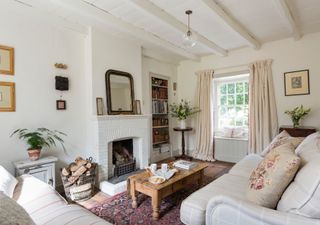
Two sofas from Sofa Workshop slot neatly into place in the compact living room. Gemma made cushions from vintage French linen sheets and quilt pieces. Most of the accessories are from auction rooms and antiques markets, or were gifts, and the coffee table is from The Shambles in Malton
Upstairs, the floors were no better – old underlay had rotted into every crack and crevice of the floorboards, and had to be painstakingly removed with knitting needles.
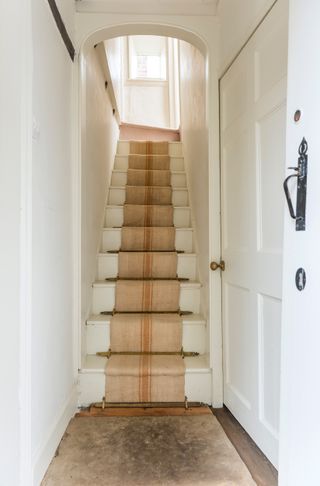
Hundreds of staples in the stairs had to be removed with pliers so Gemma and Doug could replace the old stair carpet with a French linen runner and brass rods – all polished by hand – bought from a stately home in Belfast
‘I love things that have a history to them, like old books, mixing bowls or small pieces of furniture that we can slot in among everything else. We mix old and new and only buy things we both like, even though our tastes can differ. The result is eclectic, but it works for us.’
Gemma Carsey
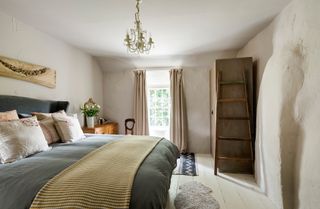
The crooked chimney breast makes a quirky feature in the master bedroom. Self-assembly wardrobes from Ikea were painted by Gemma, and the bedside tables are from Bowley & Jackson in Helmsley. The French carving is the top from an old four-poster bed, which was bought from a roadside sale in France for £180
The next major job was painting the beams, which were so heavily varnished that they looked dark and overbearing. Doug covered them with easy surface prep, and then painted on five coats of Farrow & Ball Casein distemper to get the desired finish. ‘We wanted to do the best thing, but in hindsight we should have just primed them.’
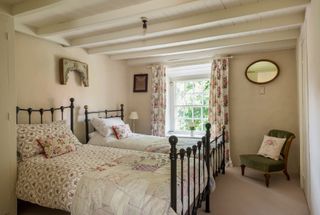
Gemma didn’t want the twin beds to look the same so bought one from The Original Bedstead Company and the other from Ebay, adding John Lewis bedlinen with vintage quilts. The cushions are made from old eiderdowns
Once they had finished decorating the cottage from top to bottom, the couple were able to move in. Although even that was not without a few problems: ‘We soon discovered that it’s almost impossible to get anything up the stairs that won’t come apart,’ says Gemma, ‘and we have had to redecorate the stair walls after scratching them when we carried up the beds.’
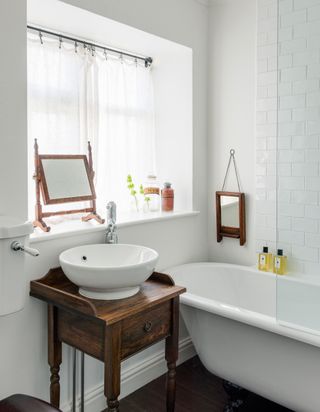
The couple created a simple, French look in the bathroom with fittings from Bathstore and Victorian Plumbing, and a wood floor from Wickes. The washstand was made by a joiner, using banister posts for the legs
Most of their old furniture is now in storage or has been given away, leaving them to buy pieces more suited to the period property. ‘We pick up pieces from all over: car boot sales, antiques shops and places we discover on our travels. One of my most expensive purchases was a carved French bedhead, which now hangs on the wall over our own bed,’ adds Gemma.
Find similar completed projects:
Join our newsletter
Get small space home decor ideas, celeb inspiration, DIY tips and more, straight to your inbox!

